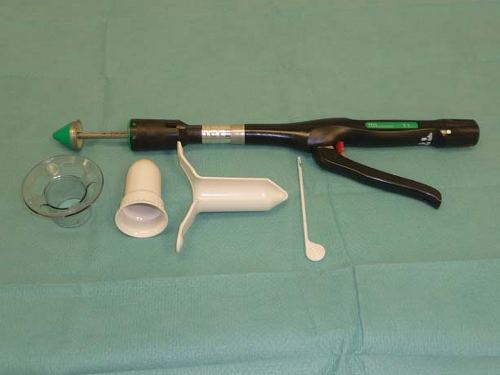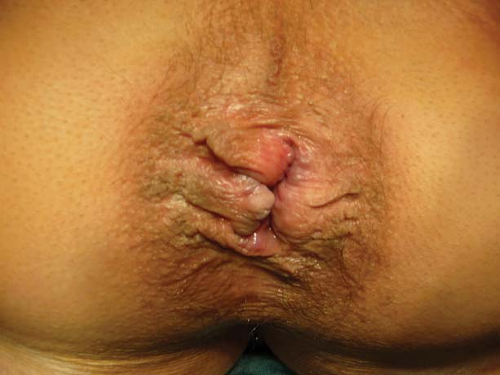Procedure for Prolapse and Hemorrhoids (PPH; Stapled Hemorrhoidopexy)
Oliver Schwandner
Stapled hemorrhoidopexy or “procedure for prolapse and hemorrhoids” (PPH) for the treatment of hemorrhoidal disease was introduced in the last decade. In contrast to conventional hemorrhoidectomy that includes submucosal excision of prolapsing hemorrhoidal tissue, stapled hemorrhoidopexy introduced by Antonio Longo in 1998 involves simultaneous circumferential resection of excess hemorrhoidal mass with mucosal anastomosis, and residual hemorrhoidal tissue that plays a major role for continence is returned to its original position (1).
According to Goligher’s classification, PPH is ideally indicated in patients with grade III hemorrhoidal prolapse (2). As outlined in Table 4.1, PPH can also be performed in prolapsed second-degree hemorrhoids that have not responded to nonsurgical interventions (e.g., rubber band ligation) or in grade II hemorrhoids with full circumferential involvement (3). PPH is also suitable for patients with hemorrhoids-associated rectal mucosal prolapse.
The use of PPH in grade IV hemorrhoidal prolapse is more controversial (4,5). A prerequisite to its use is that the hemorrhoidal prolapse should be reducible under anesthesia. However, reflecting to the authors’ experience, PPH is not recommended for grade IV, fixed and nonreducible hemorrhoidal prolapse. Only in a minority of patients suffering from hemorrhoidal prolapse grade IV for whom residual external prolapse or skin tags would not be a significant concern, the application of PPH can be discussed individually if performed by an experienced surgeon. Alternatively, PPH can be combined with segmental excisional hemorrhoidectomy or excision of skin tags.
In general, there are a few contraindications to perform PPH, which were documented in a 2003 consensus paper produced by an international working party (6). Absolute contraindications for stapled hemorrhoidopexy include anal stenosis, presence of coexistent anorectal infection (perianal sepsis, complex anorectal fistula, or abscess), anal or rectal cancer, previous coloanal anastomosis, previous sphincter reconstruction,
intra-anal condylomata, coexistent proctitis (Crohn’s disease, radiation induced), and presence of anorectal sexually transmitted diseases (Table 4.2).
intra-anal condylomata, coexistent proctitis (Crohn’s disease, radiation induced), and presence of anorectal sexually transmitted diseases (Table 4.2).
Table 4.1 Indications for Procedure for Prolapse and Hemorrhoids | |
|---|---|
|
Derived from this consensus position paper, experience with anorectal surgery, understanding of anorectal anatomy, and experience with circular stapling devices have been defined as prerequisites to perform transanal stapling procedures (6). In the era of transanal stapling procedures for hemorrhoidal prolapse, the majority of procedures can be performed by transanal stapling techniques if strict criteria of indication and patient selection are respected (7). However, although strict selection criteria for a transanal stapling approach are respected, there is a minority of patients in whom a stapling procedure is not possible or appropriate (Table 4.3); in a personal series, a 4.6% rate of “conversion” to conventional hemorrhoidectomy was documented because of anatomical, clinical, and technical factors (8). Obviously, this fact has an impact on informed consent. Therefore, every patient should be informed about anatomical and technical reasons that can make a stapling approach difficult or lead to conversion to a conventional treatment option. Consequently, experience in patient selection and alternative procedures without a stapling device is mandatory.
Focusing on patient selection, it is crucial that hemorrhoidal prolapse is reducible. Moreover, patients suffering from large external hemorrhoids or skin tags must be informed that these tags will not be routinely excised with the stapled approach. Informed consent must be obtained considering potential risks, benefits of PPH in the short term, the risk of prolapse recurrence in the long-term course, and alternative treatments (conventional excisional hemorrhoidectomy). Finally, patients must be suitable for either general or regional anesthesia.
Patient Preparation
Table 4.2 Contraindications for Procedure for Prolapse and Hemorrhoids | ||||||||||||
|---|---|---|---|---|---|---|---|---|---|---|---|---|
|
In general, no specific preparation is necessary. However, it is a general practice to preoperatively administer one or two phosphate rectal enemas. Although no evidence
derived from randomized studies exists, a single-shot antibiotic prophylaxis should be provided (e.g., cefotaxime and metronidazole). In high-risk patients, such as immunosuppressed patients, antibiotic prophylaxis is mandatory.
derived from randomized studies exists, a single-shot antibiotic prophylaxis should be provided (e.g., cefotaxime and metronidazole). In high-risk patients, such as immunosuppressed patients, antibiotic prophylaxis is mandatory.
Table 4.3 Potential Reasons for Conversion in Procedure for Prolapse and Hemorrhoids | ||||||||
|---|---|---|---|---|---|---|---|---|
|
Patient Positioning
The PPH procedure can be performed in either the prone jackknife or lithotomy position. In my personal experience, lithotomy position is preferred as it enables intraoperative transvaginal examination. Technically, it is important that the hips are completely flexed to expose the entire perineum. Skin preparation and draping are routinely carried out.
Technique
Surgery is performed in a standardized technique and described using the commercially available PPH03® procedure set (Ethicon Endo-Surgery, Cincinnati, OH, USA). The PPH set is shown in Figure 4.1. As outlined in Figure 4.2, it is ideally suitable for grade III hemorrhoids.
 Figure 4.1 PPH03 procedure set including circular stapler, obturator, circular anal dilatator, and purse-string threading instrument. |
Circular Anal Dilatator Insertion
From the technical view, a transanal stapling procedure should be performed only if the circular anal dilatator (CAD) (with the corresponding obturator) specifically created for the procedure could be inserted without any tension. It is recommended to gently dilatate the anus before inserting the obturator (Fig. 4.3). For the PPH procedure, the CAD 33 (diameter 33 mm) is used and fixed with four quadrant sutures at the anal verge (Fig. 4.4). After placement of the CAD, a gauze swab can be inserted into the distal rectum and withdrawn to expose the extent of hemorrhoidal and/or rectal mucosal prolapse. It is important that the CAD is in correct position, which includes that the dentate line is the CAD (Fig. 4.5). In fact, the dentate line should be visible through the clear plastic of the CAD.
Purse-String Suture Placement
Using a specific anoscope, a purse-string suture (2/0 Prolene; Ethicon, Somerville, NJ, USA) is submucosally placed (not including rectal muscularis propria) in a circumferential and continuous way. It is crucial that the purse-string suture is positioned either 1–2 cm above the hemorrhoidal apex or 3–5 cm above the dentate line (Fig. 4.6). Of course, this step primarily depends on the volume of hemorrhoidal tissue, but it is important not to place the suture too low or too high. In the former circumstance, significant postoperative pain and incontinence due to sensory impairment may ensue. In the latter situation, insufficient reduction of the hemorrhoids symptom persistence may occur. It is the objective of PPH to reduce hemorrhoidal prolapse rather than to excise the hemorrhoidal tissue completely.
Stapler Insertion
Following circumferential placement of the purse-string suture, the circular stapler is inserted under direct vision into the distal rectum ensuring that the head is positioned above the purse string (Fig. 4.7




Stay updated, free articles. Join our Telegram channel

Full access? Get Clinical Tree



